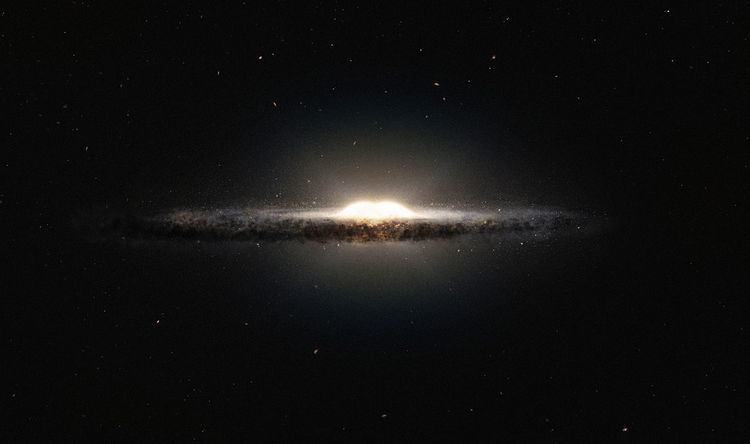 | ||
In astronomy, a bulge is a tightly packed group of stars within a larger formation. The term almost exclusively refers to the central group of stars found in most spiral galaxies (see galactic spheroid). Bulges were historically thought to be elliptical galaxies that happened to have a disk of stars around them, but high-resolution images using the Hubble Space Telescope have revealed that many bulges lie at the heart of a spiral galaxy. It is now thought that there are at least two types of bulges: bulges that are like ellipticals and bulges that are like spiral galaxies.
Contents
Classical bulges
Bulges that have properties similar to those of elliptical galaxies are often called "classical bulges" due to their similarity to the historic view of bulges. These bulges are composed primarily of stars that are older, Population II stars, and hence have a reddish hue (see stellar evolution). These stars are also in orbits that are essentially random compared to the plane of the galaxy, giving the bulge a distinct spherical form. Due to the lack of dust and gasses, bulges tend to have almost no star formation. The distribution of light is described by de Vaucouleurs' law.
Classical bulges are thought to be the result of collisions of smaller structures. These disrupt the paths of stars, resulting in the randomness of bulge orbits. Following such a merger, gas clouds are more likely to be converted into stars, due to the shocks from the merger (see star formation).
Disk-like bulges
Many bulges have properties more similar to those of the central regions of spiral galaxies than elliptical galaxies. They are often referred to as pseudobulges or disky-bulges. These bulges have stars that are not orbiting randomly, but rather orbit in an ordered fashion in the same plane as the stars in the outer disk. This contrasts greatly with elliptical galaxies.
Subsequent studies (using the Hubble Space Telescope) show that the bulges of many galaxies are not devoid of dust, but rather show a varied and complex structure. This structure often looks similar to a spiral galaxy, but is much smaller. Giant spiral galaxies are typically 2–100 times the size of those spirals that exist in bulges. Where they exist, these central spirals dominate the light of the bulge in which they reside. Typically the rate at which new stars are formed in pseudobulges is similar to the rate at which stars form in disk galaxies. Sometimes bulges contain nuclear rings that are forming stars at much higher rate (per area) than is typically found in outer disks, as shown in NGC 4314 (see photo).
Properties such as spiral structure and young stars suggest that some bulges did not form through the same process that made elliptical galaxies and classical bulges. Yet the theories for the formation of pseudobulges are less certain than those for classical bulges. Pseudobulges may be the result of extremely gas-rich mergers that happened more recently than those mergers that formed classical bulges (within the last 5 billion years). However, it is difficult for disks to survive the merging process, casting doubt on this scenario.
Many astronomers suggest that bulges that appear similar to disks form outside of the disk, and are not the product of a merging process. When left alone, disk galaxies can rearrange their stars and gas (as a response to instabilities). The products of this process (called secular evolution) are often observed in such galaxies; both spiral disks and galactic bars can result from secular evolution of galaxy disks. Secular evolution is also expected to send gas and stars to the center of a galaxy. If this happens that would increase the density at the center of the galaxy, and thus make a bulge that has properties similar to those of disk galaxies.
If secular evolution, or the slow, steady evolution of a galaxy, is responsible for the formation of a significant number of bulges, then that many galaxies have not experienced a merger since the formation of their disk. This would then mean that current theories of galaxy formation and evolution greatly over-predict the number of mergers in the past few billion years.
Most bulges are thought to host a supermassive black hole at their center. Such black holes by definition can not be observed (light cannot escape them), but various pieces of evidence strongly suggest their existence, both in the bulges of spiral galaxies and in the centers of ellipticals. The masses of the black holes correlate tightly with bulge properties; the tightest such correlation, the M–sigma relation, is between black hole mass and the velocity dispersion of stars in the bulge. Until recently it was thought that one could not have a supermassive black hole without a bulge around it, but galaxies hosting supermassive black holes without accompanying bulges have now been observed.
